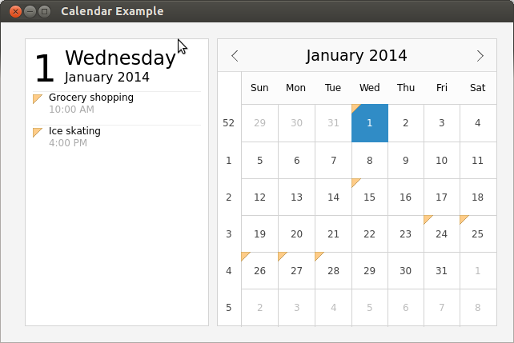Qt Quick Controls 1 - Calendar Example
Demonstrates the use of Calendar control.

The Calendar example displays a Calendar control and an events list for the selected date. It uses a C++ class to fetch the event details from an SQLite database. The example app uses a custom CalendarStyle to highlight the selected date and mark the dates that have events.
The following snippet from main.qml shows how the Calendar control is used in the app:
Calendar {
id: calendar
width: (parent.width > parent.height ? parent.width * 0.6 - parent.spacing : parent.width)
height: (parent.height > parent.width ? parent.height * 0.6 - parent.spacing : parent.height)
frameVisible: true
weekNumbersVisible: true
selectedDate: new Date(2014, 0, 1)
focus: true
style: CalendarStyle {
dayDelegate: Item {
...
}
}
}The C++ class, SqlEventModel, inherits SqlQueryModel to create a database with dummy events for certain dates.
SqlEventModel::SqlEventModel() { createConnection(); } void SqlEventModel::createConnection() { QSqlDatabase db = QSqlDatabase::addDatabase("QSQLITE"); db.setDatabaseName(":memory:"); if (!db.open()) { qFatal("Cannot open database"); return; } QSqlQuery query; // We store the time as seconds because it's easier to query. query.exec("create table Event (name TEXT, startDate DATE, startTime INT, endDate DATE, endTime INT)"); query.exec("insert into Event values('Grocery shopping', '2014-01-01', 36000, '2014-01-01', 39600)"); query.exec("insert into Event values('Ice skating', '2014-01-01', 57600, '2014-01-01', 61200)"); query.exec("insert into Event values('Doctor''s appointment', '2014-01-15', 57600, '2014-01-15', 63000)"); query.exec("insert into Event values('Conference', '2014-01-24', 32400, '2014-01-28', 61200)"); return; }
In main.qml, the SqlEventModel custom type is used to get the list of events to mark the dates on the calendar.
SqlEventModel {
id: eventModel
}
Calendar {
...
style: CalendarStyle {
dayDelegate: Item {
...
Image {
visible: eventModel.eventsForDate(styleData.date).length > 0
...
source: "qrc:/images/eventindicator.png"
}
}
}
}The app uses a Flow type to position the items, and manipulates the items' width and height based on the orientation change on mobile devices.
Calendar {
id: calendar
width: (parent.width > parent.height ? parent.width * 0.6 - parent.spacing : parent.width)
height: (parent.height > parent.width ? parent.height * 0.6 - parent.spacing : parent.height)
}
Rectangle {
width: (parent.width > parent.height ? parent.width * 0.4 - parent.spacing : parent.width)
height: (parent.height > parent.width ? parent.height * 0.4 - parent.spacing : parent.height)
border.color: Qt.darker(color, 1.2)
ListView {
...
}
}Running the Example
To run the example from Qt Creator, open the Welcome mode and select the example from Examples. For more information, visit Building and Running an Example.
Files:
- calendar/calendar.pro
- calendar/qml/main.qml
- calendar/resources.qrc
- calendar/src/event.cpp
- calendar/src/event.h
- calendar/src/main.cpp
- calendar/src/sqleventmodel.cpp
- calendar/src/sqleventmodel.h
Images:
© 2019 The Qt Company Ltd. Documentation contributions included herein are the copyrights of their respective owners. The documentation provided herein is licensed under the terms of the GNU Free Documentation License version 1.3 as published by the Free Software Foundation. Qt and respective logos are trademarks of The Qt Company Ltd. in Finland and/or other countries worldwide. All other trademarks are property of their respective owners.
